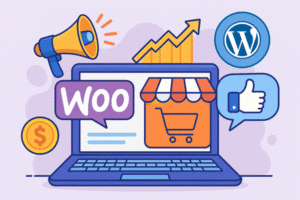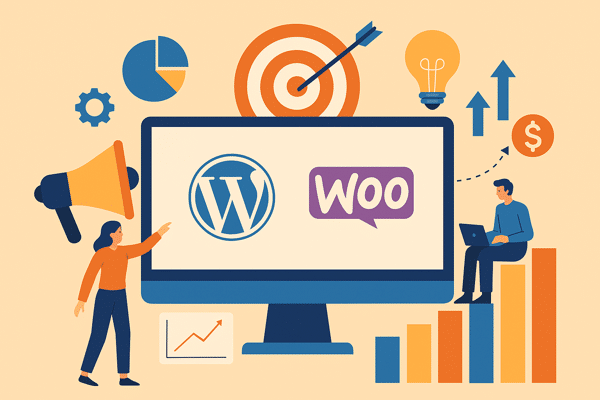WooCommerce Marketing Strategies on WordPress
Introduction to WooCommerce
WooCommerce is an open-source plugin specifically designed to provide an efficient e-commerce solution on the WordPress platform. Known for its flexibility and customization options, WooCommerce is a popular choice among store owners and entrepreneurs looking to build online stores. It allows users to sell both physical and digital products with ease, helping expand their business reach.
WooCommerce integrates seamlessly with WordPress, leveraging the existing infrastructure to make online store setup simple. Users can install the plugin directly from the WordPress dashboard and configure their store in minutes. It offers flexible design templates and supports a wide range of plugins, allowing businesses to tailor the shopping experience to meet their unique needs.

Key Features of WooCommerce
WooCommerce offers robust order and inventory management, allowing store owners to track sales and manage stock levels. It supports multiple payment options and provides detailed performance analytics. Additionally, WooCommerce includes advanced marketing features like promotions and discount coupons to attract customers and boost conversion rates.
These features make WooCommerce an ideal e-commerce platform, combining power and flexibility to help users build their stores efficiently. With a supportive community and abundant learning resources, both beginners and professionals can start using WooCommerce and grow their online businesses.
Setting Up WooCommerce on WordPress
To install WooCommerce, access your WordPress dashboard, navigate to the Plugins section, and click “Add New.” Search for “WooCommerce,” then click “Install Now” and activate the plugin once the installation is complete.
You’ll be guided through a setup wizard that asks for essential details like your store location, product types, and currency settings. Then, configure payment gateways such as PayPal or credit cards—WooCommerce supports a wide range of options.
Next, you’ll set up shipping preferences, including shipping rates, geographical zones, and delivery methods to match your product lineup. Once the basics are in place, go to the Products tab in your dashboard and click “Add New” to begin uploading your items with titles, descriptions, pricing, and images.
This process sets the foundation for launching your WooCommerce store on WordPress.
The Importance of Marketing WooCommerce
In the e-commerce world, marketing your WooCommerce store is essential to success. While WooCommerce offers powerful tools to create an online store, effective marketing strategies are required to reach your target audience and drive sales.
One of the most important aspects is SEO (Search Engine Optimization). By optimizing product descriptions and content, you can improve your search engine rankings and attract more organic traffic. Paid ads and social media can also play a major role in increasing brand visibility and traffic.
Furthermore, engaging customers through email marketing strengthens loyalty. Sending personalized updates, promotions, and valuable content helps build a community around your store and encourages repeat purchases.
Using analytics tools to study shopper behavior and preferences helps you identify the most effective strategies, enabling you to optimize performance and grow your store.
Effective Marketing Strategies for WooCommerce
Successful WooCommerce marketing strategies include a mix of SEO, email campaigns, and social media advertising:
-
SEO Optimization:
Improve search rankings by optimizing product titles, descriptions, and using relevant keywords. Analyze competitors, avoid keyword stuffing, and ensure product pages are SEO-friendly.
-
Email Marketing:
Reach both current and potential customers through personalized campaigns. Promote exclusive offers and discounts to encourage repeat purchases and customer loyalty.
-
Social Media Marketing:
Platforms like Facebook and Instagram are ideal for product showcasing and real-time customer engagement. Use targeted ads and sponsored posts to maximize reach and conversions.
By combining these strategies, WooCommerce store owners can boost visibility, increase sales, and ensure long-term sustainability.
Using SEO to Optimize a WooCommerce Store
SEO is vital for increasing your WooCommerce store’s visibility and attracting customers. Proper implementation can significantly improve your search engine rankings.
- Focus on keyword research—identify the terms customers use when searching for your products, and include these in product titles and descriptions.
- Ensure that descriptions are informative, engaging, and naturally include target keywords. Good content improves both search visibility and encourages conversions.
By applying effective SEO techniques, WooCommerce stores can improve search rankings, attract more traffic, and ultimately boost revenue.

Social Media Marketing
Social media is a powerful tool for promoting WooCommerce stores on WordPress. It helps businesses reach broader audiences and build brand awareness through strategic content.
- Define your target audience and tailor content to their interests.
- Use paid advertising with precise audience targeting based on location, behavior, and interests.
- Create engaging visual content (photos, videos) and share customer stories or testimonials to build trust.
By implementing a well-planned social media strategy, you can drive interaction, improve engagement, and increase your store’s online presence.
Performance Analytics and Forecasting
Performance analytics are key to the success of any WooCommerce store. Tools like Google Analytics provide insights into visitor behavior, allowing store owners to measure campaign effectiveness and optimize performance.
Track metrics such as:
- Visitor numbers
- Conversion rates
- Top-performing pages
Tools like Hotjar and Crazy Egg offer heatmaps and screen recordings that reveal how users interact with your store. This helps identify usability issues and improve the shopping experience.
Data analytics can also be used for predictive forecasting, helping you plan campaigns based on historical trends and consumer preferences.
Customer Experience and Partnerships
Improving the customer experience is critical for WooCommerce marketing success. Personalized offers, fast support, and product recommendations based on user behavior foster loyalty.
Providing excellent customer support and responding quickly to inquiries enhances trust and encourages repeat purchases. Additionally, user-generated reviews and ratings build credibility and influence new buyers.
Partnerships with influencers or complementary brands can help expand your reach. Joint promotions or exclusive deals add value to your customer experience and create a sense of community.
These strategies improve engagement and customer retention, essential for long-term success.
The Future of WooCommerce and Marketing
WooCommerce holds a leading position in e-commerce, thanks to its ability to meet the needs of both sellers and customers. As we’ve explored, strategies like SEO, social media, and content marketing are crucial to attracting customers and building brand awareness.
Looking ahead, AI and data analytics will play an increasingly important role. Machine learning can help personalize offerings and identify trends, leading to more satisfying shopping experiences.
Enhancing user experience (UX) will also be a central focus. Streamlined interfaces, mobile payment integration, and social commerce features will be critical to future marketing strategies.
In conclusion, WooCommerce’s future lies in innovation and adaptability. Embracing modern technologies and marketing methods will be key for store owners aiming to succeed in a competitive digital market.





Love this topic! It gives marketers a real edge — from automation to analytics, tools make every move smarter.
This topic highlights the beauty of one-on-one engagement — direct marketing builds trust and drives action!